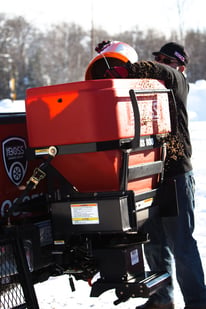Winter is behind us, but as many seasoned snow and ice management professionals know, the snow business requires attention even during the summer months. Depending on your situation, this could mean getting an order for deicers in now. But first, you must determine what kind of deicer you require and how much of it.

Type of Accounts You Service
The type of accounts you service is going to be a huge factor in what kind of deicers you require. If you service homeowner’s they may have pets, which means they may require a pet safe brand of deicer. Or they may be concerned about their lawn which means they might want a deicer that is less harsh on the environment around their home. Remember to do your research and to use the specific deicers according to your customer’s needs.
How Many Accounts Do You Service
Undoubtedly, the number of accounts you service will affect the quantity of deicers you will require. More accounts, or accounts that have larger square footage, will require more deicers. Keep this in mind when buying or ordering your deicing materials.
Storage as a Constraint
Where you plan on storing your salt is another factor in determining when you purchase deicers, how much you can hold at one time, and potentially what you’ll pay for them. You don’t want to store salt or any other deicers outside without any cover or container. This can have negative results on the environment, you can damage your deicer and it could result in governmental fines. If you have storage facilities for your salt and other deicers, this will allow you to buy them whenever the price is the lowest and store it for future use, whereas if you do not have storage for your deicers or have a relatively small storage area, you are, more often than not, at the mercy of the current prices for the day.
Budgetary Constraints
What you choose to buy as deicers will vary depending on your available budget for them. Bagged deicers are in most cases the most expensive option when you consider the volume of material you get per bag. Sand is generally the least expensive option and bulk salt typically falls somewhere in between those two.
Type of Snow Your Area Usually Sees
Ice melt can be either coarse or fine or anywhere in between. Different sized particles serve different purposes. A larger particle will be heavier. Meaning, as it melts, it can sink down into deeper snow that hasn’t been plowed away yet, all the way to the pavement. On the other hand, finer particles are smaller and therefore not as heavy, but they cover a greater amount of surface area. Knowing this, you can make the decision on what to purchase, or if you have both types, when to service and with which material.
How Cold Does It Usually Get
Temperature, similar to the type of snow you usually get, will determine what type of ice melt will be most effective on the areas you service. All deicers have a temperature in which they will begin to lose their melting ability. This temperature will vary from product to product. For example, Calcium Chloride can melt ice all the way down to when it’s -25° F outside while Sodium Chloride (rock salt) only melts to 5°. However, even if a deicer can melt down to a certain temperature, doesn’t mean that it will be as effective as it could be if it were at a warmer temperature. Going back to the Calcium Chloride example, while it has the ability to melt all the way down to -25° F, you will see it be much more effective at removing more ice at -10° F and even more so as the temperature outside rises. There comes a point when it’s so cold outside that it may be best to use sand to gain traction rather than trying to melt the ice. So, depending on where you are located and how cold it typically gets during winter can help guide you to what kind of material to purchase.
Equipment
As you have probably guessed, the spreader equipment you own or are looking to purchase will be yet another huge factor in what kind of deicer you will be able to run through your machine. Spreaders are generally tailored to the type of materials they can handle, which vehicles they can safely be applied to, and vary in many shapes, sizes and features. Deciding what equipment to use is an entirely different, yet still heavily linked process, from material purchasing.
Ultimately, we advise that you do your research! We can’t stress enough that there are a wide variety of materials made with different chemicals, spread differently and have very different effects on melting snow and ice. Remember, each deicing material is unique from another in a number of different ways. Look at manufacturer recommendations and go from there.


